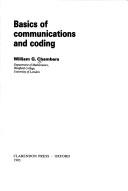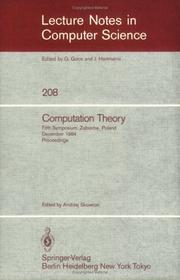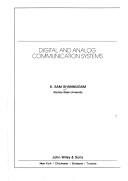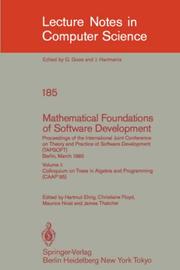| Listing 1 - 6 of 6 |
Sort by
|

ISBN: 9780198531944 019853194X Year: 1985 Publisher: Oxford: Clarendon,
Abstract | Keywords | Export | Availability | Bookmark
 Loading...
Loading...Choose an application
- Reference Manager
- EndNote
- RefWorks (Direct export to RefWorks)
Book
ISBN: 3540156585 0387156585 3540395687 9783540156581 Year: 1985 Volume: 196 Publisher: Berlin Heidelberg New York Springer
Abstract | Keywords | Export | Availability | Bookmark
 Loading...
Loading...Choose an application
- Reference Manager
- EndNote
- RefWorks (Direct export to RefWorks)
Recently, there has been a lot of interest in provably "good" pseudo-random number generators [lo, 4, 14, 31. These cryptographically secure generators are "good" in the sense that they pass all probabilistic polynomial time statistical tests. However, despite these nice properties, the secure generators known so far suffer from the han- cap of being inefiicient; the most efiicient of these take n2 steps (one modular multip- cation, n being the length of the seed) to generate one bit. Pseudc-random number g- erators that are currently used in practice output n bits per multiplication (n2 steps). An important open problem was to output even two bits on each multiplication in a cryptographically secure way. This problem was stated by Blum, Blum & Shub [3] in the context of their z2 mod N generator. They further ask: how many bits can be o- put per multiplication, maintaining cryptographic security? In this paper we state a simple condition, the XOR-Condition and show that any generator satisfying this condition can output logn bits on each multiplication. We show that the XOR-Condition is satisfied by the lop least significant bits of the z2-mod N generator. The security of the z2 mod N generator was based on Quadratic Residu- ity [3]. This generator is an example of a Trapdoor Generator [13], and its trapdoor properties have been used in protocol design. We strengthen the security of this gene- tor by proving it as hard as factoring.
cryptografie --- cryptologie --- Information systems --- Computer security --- Cryptography --- Sécurité informatique --- Cryptographie --- Congresses --- Congrès --- 621.391.7 --- 681.3*E3 --- Secret systems of electrical communication --- Data encryption: data encryption standard; DES; public key cryptosystems --- 681.3*E3 Data encryption: data encryption standard; DES; public key cryptosystems --- 621.391.7 Secret systems of electrical communication --- Sécurité informatique --- Congrès --- Information theory. --- Coding theory. --- Data encryption (Computer science). --- Theory of Computation. --- Coding and Information Theory. --- Cryptology. --- Data encoding (Computer science) --- Encryption of data (Computer science) --- Data compression (Telecommunication) --- Digital electronics --- Information theory --- Machine theory --- Signal theory (Telecommunication) --- Computer programming --- Communication theory --- Communication --- Cybernetics --- Computers. --- Access control

ISBN: 0198531958 Year: 1985 Publisher: Oxford Clarendon
Abstract | Keywords | Export | Availability | Bookmark
 Loading...
Loading...Choose an application
- Reference Manager
- EndNote
- RefWorks (Direct export to RefWorks)
Coding theory --- Digital communications --- Statistical communication theory --- 681.3*E4 --- Stochastic information theory --- Information theory --- Probabilities --- Rate distortion theory --- Telecommunication --- Communications, Digital --- Digital transmission --- Pulse communication --- Digital electronics --- Pulse techniques (Electronics) --- Digital media --- Signal processing --- Data compression (Telecommunication) --- Machine theory --- Signal theory (Telecommunication) --- Computer programming --- 681.3*E4 Coding and information theory: data compaction and compression; formal modelsof communication; nonsecret encoding schemes--See also {681.3*H11} --- Coding and information theory: data compaction and compression; formal modelsof communication; nonsecret encoding schemes--See also {681.3*H11} --- Digital techniques --- Mathematical control systems

ISBN: 3540160663 0387160663 3540397485 Year: 1985 Volume: vol 208 Publisher: Berlin Heidelberg New York Springer
Abstract | Keywords | Export | Availability | Bookmark
 Loading...
Loading...Choose an application
- Reference Manager
- EndNote
- RefWorks (Direct export to RefWorks)
Computer science --- Discrete mathematics --- 681.3*F0 --- 681.3*G2 --- 681.3*I24 --- 681.3*I26 --- Computerwetenschap--?*F0 --- Discrete mathematics (Mathematics of computing) --- Knowledge representation formalisms and methods: frames and scripts; predicate logic; relation systems; representation languages; procedural and rule-based representations; semantic networks (Artificial intelligence) --- Learning: analogies; concept learning; induction; knowledge acquisition; language acquisition; parameter learning (Artificial intelligence)--See also {681.3*K32} --- Machine theory --- Computational complexity --- Congresses. --- 681.3*I26 Learning: analogies; concept learning; induction; knowledge acquisition; language acquisition; parameter learning (Artificial intelligence)--See also {681.3*K32} --- 681.3*G2 Discrete mathematics (Mathematics of computing) --- 681.3*I24 Knowledge representation formalisms and methods: frames and scripts; predicate logic; relation systems; representation languages; procedural and rule-based representations; semantic networks (Artificial intelligence) --- Mathematics. --- Computer software. --- Information theory. --- Mathematics, general. --- Algorithm Analysis and Problem Complexity. --- Theory of Computation. --- Communication theory --- Communication --- Cybernetics --- Software, Computer --- Computer systems --- Math --- Science

ISBN: 0471063029 0471030902 9780471030904 Year: 1985 Publisher: New York John Wiley & Sons
Abstract | Keywords | Export | Availability | Bookmark
 Loading...
Loading...Choose an application
- Reference Manager
- EndNote
- RefWorks (Direct export to RefWorks)
Telecommunication --- Digital communications --- Information theory --- Signal theory (Telecommunication) --- Digital communications. --- Information theory. --- Signal theory (Telecommunication). --- Telecommunication. --- Communicatietheorie. --- Digitale technieken. --- Informatietheorie. --- telecommunicatie --- informatietechnologie --- Computer architecture. Operating systems --- analoge technieken --- Electronics --- technologische innovatie --- digitale technieken --- #TCPW P4.0 --- #TCPW P4.6 --- #TCPW P7.5 --- #TCPW P7.7 --- 621.395 --- 681.3*B0 --- 681.3*C0 --- Electric communication --- Mass communication --- Telecom --- Telecommunication industry --- Telecommunications --- Communication --- Telecommuting --- Electric signal theory --- Electric waves --- Signal detection --- Communication theory --- Cybernetics --- Communications, Digital --- Digital transmission --- Pulse communication --- Digital electronics --- Pulse techniques (Electronics) --- Digital media --- Signal processing --- 621.395 Telephony --- Telephony --- Computerwetenschap--?*B0 --- Computerwetenschap--?*C0 --- Digital techniques --- 621.391 --- analoge techniek (analoge elektronica) --- communicatiesysteem --- digitale techniek --- 621.391 General questions of electrical communication engineering. Cybernetics. Information theory. Signal theory --- General questions of electrical communication engineering. Cybernetics. Information theory. Signal theory --- Datacommunicatie

ISBN: 3540151982 0387151982 3540151990 0387151990 3540393021 3540393072 9783540151982 9783540151999 Year: 1985 Volume: 185-186 Publisher: Berlin Heidelberg New York Springer
Abstract | Keywords | Export | Availability | Bookmark
 Loading...
Loading...Choose an application
- Reference Manager
- EndNote
- RefWorks (Direct export to RefWorks)
Programming --- Computer software --- Logiciels --- Development --- Congresses --- Développement --- Congrès --- 681.3*D22 --- 681.3*E1 --- 681.3*F --- 681.3*F3 --- 681.3*F4 --- Tools and techniques: decision tables; flow charts; modules and interfaces; programmer workbench; software libraries; structured programming; top-down programming; user interfaces (Software engineering) --- Data structures: arrays; graphs; lists; tables; trees --- Theory of computation --- Logics and meanings of programs (Theory of computation) --- Mathematical logic and formal languages (Theory of computation) --- 681.3*D0 --- 681.3*D2 --- Computerwetenschap--?*D0 --- Software engineering: protection mechanisms; standards--See also {681.3*K63}; {681.3*K51} --- 681.3*F4 Mathematical logic and formal languages (Theory of computation) --- 681.3*F3 Logics and meanings of programs (Theory of computation) --- 681.3*F Theory of computation --- 681.3*E1 Data structures: arrays; graphs; lists; tables; trees --- 681.3*D22 Tools and techniques: decision tables; flow charts; modules and interfaces; programmer workbench; software libraries; structured programming; top-down programming; user interfaces (Software engineering) --- 681.3*D2 Software engineering: protection mechanisms; standards--See also {681.3*K63}; {681.3*K51} --- Développement --- Congrès --- Software engineering. --- Computer science. --- Logic design. --- Software Engineering/Programming and Operating Systems. --- Software Engineering. --- Programming Languages, Compilers, Interpreters. --- Logics and Meanings of Programs. --- Information theory. --- Combinatorics. --- Theory of Computation. --- Design, Logic --- Design of logic systems --- Digital electronics --- Electronic circuit design --- Logic circuits --- Machine theory --- Switching theory --- Informatics --- Science --- Computer software engineering --- Engineering --- Combinatorics --- Algebra --- Mathematical analysis --- Communication theory --- Communication --- Cybernetics --- Congresses.
| Listing 1 - 6 of 6 |
Sort by
|

 Search
Search Feedback
Feedback About
About Help
Help News
News